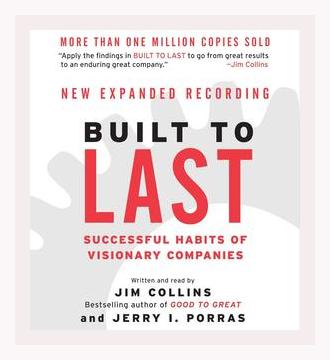Entrepreneurship and StartupsBusiness Models
Introduction
“Built to Last” by Jim Collins and Jerry Porras is a seminal work in the field of business models, focusing on identifying and analyzing the common characteristics of visionary companies that have stood the test of time. The authors distill their findings into actionable insights that can help other companies and individuals emulate the remarkable success of these enduring firms. Drawing from extensive research, Collins and Porras compare pairs of companies within the same industries to differentiate the truly visionary firms from their less successful counterparts. This summary covers the main concepts of the book, supported by concrete examples and actionable steps.
Core Concepts
Visionary Companies
Visionary companies are defined as premier institutions in their industries that are widely admired and have been successful across multiple generations of leadership and various product life cycles.
Example:
- 3M: Known for its continuous innovation and ability to adapt over time, maintaining leadership in multiple product categories.
Actionable Step:
– Identify and foster a clear and compelling core purpose for your organization that goes beyond making money, to inspire and guide your decisions and strategies.
Clock Building, Not Time Telling
Visionary companies focus on building mechanisms that produce great outcomes consistently over time, rather than relying on charismatic leaders or revolutionary products alone.
Example:
- Hewlett-Packard (HP): HP established a set of core values and organizational mechanisms (like the “HP Way”) that survived the founders and ensured ongoing innovation and success.
Actionable Step:
– Develop and codify a set of core values and operating principles that can guide your company regardless of who is in charge or what the market conditions are.
Core Ideology and Envisioned Future
Visionary companies maintain a core ideology that consists of core values and a core purpose, which remain unchanged while their business strategies and practices adapt to the changing world.
Example:
- Wal-Mart: Founded by Sam Walton, Wal-Mart’s core values around customer service, respect for individuals, and striving for excellence have driven the company’s success across various decades.
Actionable Step:
– Articulate your organization’s core values and ensure they are deeply embedded in every aspect of your company’s culture and operations.
Preserve the Core/Stimulate Progress
Visionary companies are adept at maintaining their core ideology while simultaneously driving change and innovation.
Example:
- Procter & Gamble (P&G): Despite being over a century old, P&G has constantly evolved its product lines and marketing strategies while preserving its core commitment to product quality and customer satisfaction.
Actionable Step:
– Encourage a culture of continual improvement and innovation, even as you hold fast to your core principles and purpose.
BHAGs (Big Hairy Audacious Goals)
Visionary companies set ambitious, clear, and compelling long-term goals that serve as powerful motivators and unifiers.
Example:
- Boeing: In the 1960s, Boeing set a BHAG to build the first large, long-range commercial jet (the 747), which revolutionized air travel and established Boeing’s dominance in the aerospace industry.
Actionable Step:
– Establish a bold and ambitious goal for your organization that is clear, compelling, and energizing, pushing your team to achieve greatness.
Cult-like Cultures
Visionary companies often have strong organizational cultures that are almost cult-like in their intensity, which helps in preserving core values and driving performance.
Example:
- Nordstrom: Known for its legendary customer service, Nordstrom’s culture is so strong that employees naturally sustain high service standards.
Actionable Step:
– Actively cultivate a robust and cohesive company culture that aligns with your core ideology, using rituals, stories, and heroes to reinforce cultural values.
Try a Lot of Stuff and Keep What Works
Visionary companies often experiment with new ideas and are willing to take risks and learn from their failures to find the best strategies for success.
Example:
- Sony: Sony’s willingness to try numerous new products and technologies led to breakthroughs such as the Walkman, which created an entirely new market category.
Actionable Step:
– Foster a culture of experimentation where failing is an acceptable part of the innovation process, encouraging teams to continually test new ideas and adapt based on what they learn.
Home-Grown Management
Visionary companies tend to promote leaders from within the organization who are deeply familiar with and committed to the company’s core values and culture.
Example:
- General Electric (GE): GE has a tradition of identifying and developing talent from within, ensuring leadership continuity that aligns with the company’s core principles and long-term goals.
Actionable Step:
– Develop a robust internal development program to identify, nurture, and promote talent from within, ensuring that future leaders are steeped in your organization’s values and culture.
Good Enough Never Is
Visionary companies constantly strive for perfection and never settle for “good enough,” engaging in a relentless pursuit of excellence.
Example:
- Johnson & Johnson: Their unwavering commitment to quality and safety led to the famous Tylenol crisis handling, where they prioritized customer safety over immediate profits, reinforcing trust in the brand.
Actionable Step:
– Encourage a mindset of continuous improvement where every team member is always looking for ways to enhance performance, product quality, and customer experience.
Conclusion
“Built to Last” offers a comprehensive analysis of what makes some companies not just successful but visionary and enduring. By examining companies like 3M, HP, Wal-Mart, P&G, Boeing, Nordstrom, Sony, GE, and Johnson & Johnson, Collins and Porras offer insights into the principles and practices that drive long-term success. The key takeaway is the importance of balancing the preservation of core values with the stimulation of progress. By implementing actionable steps based on the book’s findings, businesses and individuals can aspire to build organizations that stand the test of time.
By encapsulating these core concepts and actionable steps, anyone seeking to learn from the habits of visionary companies can apply these principles to their own organizational contexts, fostering enduring success.
